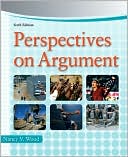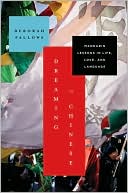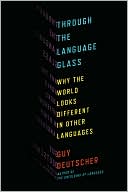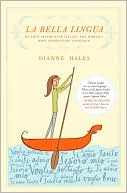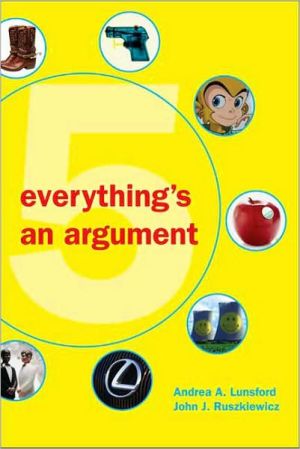Perspectives on Argument
Search in google:
This combination rhetoric/reader helps readers develop strategies for critical reading, critical thinking, research, and writing that will help the reader argue clearly and convincingly. It teaches them to identify and develop arguments, to read and form reactions and opinions of their own, to analyze an audience, to seek common ground, and to use a wide, realistic range of techniques to write argument papers that express their individual views and original perspectives on modern issues.
Table of Contents:Part I: Engaging with Argument for Reading, Writing, and Viewing ImagesChapter 1: A Perspective on ArgumentWhat Is Your Current Perspective on Argument?A Definition of ArgumentRecognizing Traditional and ConsensualArgumentRecognizing Visual ArgumentUnder What Conditions Does Argument Work Best?Under What Conditions Does Argument Fail?Distinguish between Ethical and Unethical ArgumentEngaging with IssuesHow Should You Engage with Issues?Review QuestionsExercises and ActivitiesEssays for Analysis:AUDREY ROCK-RICHARDSON / Pay Your Own Way! (Then Thank Mom) ABBY ELLIN / The Laptop Ate My Attention SpanPRISNA VIRASIN / The Barbie ControversyImages for Analysis:Image 1. Blessed Art Thou Image 2. The Tide Is HighChapter 2: Identifying Your Preferred Argument StyleThe Adversarial and Consensual Styles of ArgumentIndividual Styles of ArgumentInfluence of Background, Experience, and Role ModelsInfluence of GenderInfluence of CultureA Study of the Influence of Students’ Gender and Culture on Their Argument StyleInfluence of NationalityReview QuestionsExercises and ActivitiesEssays for Analysis:SHIRLEE TAYLOR HAIZLIP / We Knew What Glory Was RANDALL HAMUD / We’re Fighting Terror, But Killing FreedomCHANG-LIN TIEN / A View from BerkeleyERNEST MARTINEZ / Giving People a Second ChanceSUZETTE BREWER / One of Our Own: Training Native Teachers for the 21st CenturyJUDY BRADY / Why I Want a WifeREIKO HATSUMI / A Simple “Hai” Won’t DoImages for Analysis: Five AdvertisementsImage 1. Mary J. Blige and Her New Car Image 2. Young Man Doing His Banking Image 3. If I Stay on the Rez Image 4. Blood Donor Image 5. Cell Phones in Africa Chapter 3: The Rhetorical Situation: Understanding Audience and ContextAnalyze the Rhetorical Situation When You Read an ArgumentAnalyze the Rhetorical Situation When You View a Visual Image That Makes an ArgumentUse the Rhetorical Situation When You Write ArgumentConducting an Audience AnalysisReview QuestionsExercises and ActivitiesEssays for Analysis:CHRIS PIPER / “A” Is for “Absent” BRENT STAPLES / Driving Down the Highway, Mourning the Death of American Radio PETER APPLEBOME / The Man behind Rosa Parks NEIL A. LEWIS / In the Shadow of Horror, SS Guardians Relax and FrolicImages for Analysis:Image 1. Rosa Parks Rides in the Front of the Bus Image 2. Auschwitz victims of Medical Experiments Image 3. Camp Officials at Leisure Chapter 4: Reading, Thinking, and Writing about IssuesGetting Started on a Writing AssignmentRead to Develop Arguments for Your PaperTake Notes and Avoid PlagiarismWrite Your Paper, Read It, Think about It, and Revise ItOrganize Your Own Process for Reading, Thinking, and Writing about IssuesPractice Your Process by Writing These PapersSubmit Your Paper for Peer ReviewExpressing Multiple Perspectives through Visual ArgumentReview QuestionsExercises and ActivitiesEssays for Analysis:JERRY ADLER / The Race for SurvivalGINA KOLATA / Psst! Ask for Donor 1913LANCE MORROW / The Year That Changed EverythingJEFF D. OPDYKE / Kids and Chores: All Work and No Pay?PRISNA VIRASIN / The Controversy Behind BarbieMAJOR GENERAL ROBERT SCALES (RET.) / Forget Flag Burning Images for Analysis:Image 1. Sperm DonorsImage 2. Three Perspectives on the American Flag as a SymbolPart II: Understanding the Nature of Argument for Reading, Writing, and Viewing ImagesChapter 5: The Essential Parts of an Argument: The Toulmin ModelThe Outcomes of Argument: Probability versus CertaintyThe Parts of an Argument According to the Toulmin ModelValue of the Toulmin Model for Reading, Writing, and Viewing ArgumentReview QuestionsExercises and ActivitiesImages for Analysis:Image 1. Sense of Community, Advertisement Image 2. “The Price of Oranges” Cartoon Essays for Analysis:VIRGINIA HEFFERNAN / Calling Blue: And on That Farm He Had a Cellphone MOHAMED T. DIABY JR. / Toulmin Analysis of “The Price of Oranges” Cartoon RICHARD D. RIEKE AND MALCOLM O. SILLARS / American Value Systems Chapter 6: Types of ClaimsGetting a Sense of the Purpose and Parts of an ArgumentFive Types of ClaimsClaims and Argument in Real LifeValue of the Claims Types and the Claim Questions for Reading, Viewing, and Writing ArgumentReview QuestionsExercises and ActivitiesEssays for Analysis:HAYA EL NASSER / Fewer Call Themselves Multiracial EDITORIAL / Brother, Can You Spare a Word? NICHOLAS BAKALAR / Nicotine Addiction Is Quick in Youths, Research Finds MORTIMER B. ZUCKERMAN / What Sets Us Apart KURT WIESENFELD / Making the Grade MICHAEL CRICHTON / Let’s Stop Scaring Ourselves JIM HOLT / Unintelligent Design BARRY SCHWARTZ / When It’s All Too Much DENISE GRADY / War Casualty Total Jumps, But Is Revised after Article IAN URGINA / No Need to Stew: A Few Tips to Cope with Life’s Annoyances PEG TYRE / Bringing Up Adultolescents Images for Analysis:Image 1: War Casualties Image 2: Lunch at the United States—Mexico Border Fence Image 3: The Rhône Glacier Image 4. Liberate Your Cool, Advertisement Image 5: Corn Power Chapter 7: Types of ProofThe Traditional Categories of ProofTypes of Logical Proof: Logos Proof That Builds Credibility: EthosTypes of Emotional Proof: Pathos Logos, Ethos, and Pathos Communicated Through Language and StyleValue of the Proofs for Reading, Writing, and Viewing ArgumentReview QuestionsExercises and ActivitiesEssays for Analysis:ANNA QUINDLEN / Undocumented, IndispensableJEFFREY SACHS / Sharing the Wealth THOMAS JEFFERSON / The Declaration of Independence Images for Analysis:Image 1: Meet the Philip Morris Generation, Advertisement Image 2: Helping Out Image 3: Who Has the Money, Chart Image 4: Malnutrition in the Congo Image 5: Kenyan Refugees Chapter 8: The Fallacies and Ethical ArgumentFallacies in LogicFallacies That Affect Character or EthosEmotional FallaciesEthics and Morality in ArgumentReview QuestionsExercises and ActivitiesImages for Analysis: Three AdvertisementsImage 1: A Vitamins Ad Image 2: A Body Spray Ad Image 3: An Ad for a Blog Essay for Analysis:RUSH LIMBAUGH / The Latest from the Feminist “Front” KELLY DICKERSON / Minor Problems? Essay with Images for Analysis:ABRAHAM LINCOLN / The Gettysburg Address Image 1. President Lincoln amid the Crowd at Gettysburg Battlefield Image 2. The Soldiers’ National Monument, Gettysburg, Pennsylvania Chapter 9: Visual ArgumentRecognizing Visual ArgumentWhy Visual Argument Is Convincing: Eight Special FeaturesUsing Argument Theory to Critique Visual ArgumentBias in Visual ArgumentSample Analysis of a Visual ArgumentSpecial Features of Visual Argument Employed in the CartoonArgument Theory Used for Analysis of the CartoonAdd Visual Argument to Support Written ArgumentCreate Visual Arguments That Stand AloneReview QuestionsExercises and ActivitiesImages for Analysis:Image 1. West Bank Barrier Image 2. Crossing Over Image 3. Coming Home to a Destroyed Neighborhood Image 4. Mother and Child Image 5. LeBron James Image 6. At Home Outdoors Multiple Visual Perspectives on an Issue for Analysis:Image 1. Adam and God Image 2. Play Ball Image 3. Robot with a Grappler Image 4. Missionary and Child Cartoon: "Get Out!” for Analysis Visual Arguments Created by Students:Student Visual Argument 1. Untitled Artwork Student Visual Argument 2. Never Again Analytical Essay on Never Again Student Visual Argument 3. Farm Town News Analytical Essay on Farm Town News Chapter 10: Rogerian Argument and Common GroundAchieving Common Ground in Rogerian ArgumentRogerian Argument as StrategyWriting Rogerian ArgumentVariations of Rogerian ArgumentUnethical and Ethical Rogerian ArgumentThe Advantages and Disadvantages of Rogerian ArgumentReview QuestionsExercises and ActivitiesEssays for Analysis:EDWARD O. WILSON / The Future of Life ANGELA A. BOATWRIGHT / Human Cloning: Is It a Viable Option? ERIC HARTMAN / Let Those Who Ride Decide! ELIZABETH NABHAN / Dear Boss Images for Analysis:Image 1. Hands Across the World Image 2. Bridging the Gap Image 3. Bipartisanship and What It Can Achieve Appendix to Chapter 10: Review and Synthesis of the Strategies for Reading, Writing, and Argument Viewing–The Argument Analysis PaperReading for the Argument Analysis PaperWriting the Argument Analysis PaperRhetorical Situation for “A Call to Unity: A Letter from Eight White Clergymen” and “Letter from Birmingham Jail”Focus Topics to Help You Analyze the LettersLetters for AnalysisA Call for Unity: A Letter from Eight White Clergymen MARTIN LUTHER KING JR. / Letter from Birmingham Jail Review QuestionsExercises and ActivitiesPart III: Writing a Research Paper That Presents an ArgumentChapter 11: The Research Paper: Clarifying Purpose and Understanding the AudienceUnderstanding the Assignment and Getting StartedWriting a Claim and Clarifying Your PurposeSome Preliminary Questions to Help You Develop Your ClaimDeveloping a Research PlanUnderstanding the AudienceAnalyzing Your Class as Your AudienceConstructing an Unfamiliar AudienceUsing Information about Your AudienceReview QuestionsExercises and ActivitiesChapter 12: The Research Paper: Research and InventionGet Organized for ResearchLocating Sources for ResearchEvaluate Both Print and Online SourcesCreate a BibliographySurvey, Skim, and Read SelectivelyDevelop a System for Taking and Organizing Your NotesTwo Invention Strategies to Help You Think Creatively about Your Research and Expand Your Own IdeasReview QuestionsExercises and ActivitiesAdd Visual Material to the Annotated BibliographyEXAMPLE IMAGE / Welcome Clones of 2012! Annotated BibliographyANGELA A. BOATWRIGHT / Human Cloning: An Annotated BibliographyChapter 13: The Research Paper: Organizing, Writing, and RevisingClassical Organization of ArgumentsClassical and Modern OrganizationUse Organizational Patterns to Help You Think and OrganizeIncorporate Ideas from Your Exploratory PaperHow to Match Patterns and Support to ClaimsOutline Your Paper and Cross-Reference Your NotesIncorporating Research into Your First DraftMake Revisions and Prepare the Final CopyPresent Your Paper Orally to the ClassReview QuestionsExercises and ActivitiesAppendix to Chapter 13: How to Document Sources UsingMLA and APA StylesMLA: HOW TO CITE SOURCES IN THE BODY OF THE TEXTMLA: HOW TO CITE SOURCES IN THE “WORKS CITED” PAGEMLA: STUDENT PAPER IN MLA STYLEPRISNA VIRASIN / The Big Barbie ControversyQUESTIONS ON THE RESEARCHED POSITION PAPER, MLA STYLEAPA: HOW TO CITE SOURCES IN THE BODY OF THE TEXTAPA: HOW TO CITE SOURCES IN THE “REFERENCES” PAGEAPA: STUDENT PAPER IN APA STYLEDARRELL D. GREER / Alaskan Wolf Management QUESTIONS ON THE RESEARCHED POSITION PAPER, APA STYLEPart IV: Further Applications: Argument and LiteratureChapter 14: Argument and LiteratureFinding and Analyzing Arguments in LiteratureWriting Arguments about LiteratureReview QuestionsExercises and ActivitiesLiterature for Analysis:Poem / LANGSTON HUGHES / Theme for English BPoem / TAYLOR MALI / Totally Like Whatever, You Know?Poem / ROBERT FROST / Mending WallShort Story / URSULA K. LE GUIN / The Ones Who Walk Away from OmelasGraphic Novel / ART SPIEGELMAN / Maus: A Survivor’s TaleSynthesis of Chapters 1-14: Summary ChartsPart V: The ReaderIntroduction to “The Reader”: Reading and Writing about Issue Areas Purpose of “The Reader”How to Use “The Reader”Section 1: Issues Concerning Families and Personal RelationshipsThe IssuesWeb Sites for Further Exploration and ResearchFilms and Literature Related to Families and Personal RelationshipsThe Rhetorical SituationA. WHAT IS THE STATUS OF THE TRADITIONAL AMERICAN FAMILY? HOW IS THE FAMILYBEING REDEFINED? MEGAN KELSO / Watergate Sue: EpilogueSARAH YOEST PEDERSON / A Family of a Different FeatherLISA TAKEUCHI CULLEN AND LEV GROSSMAN / Fatherhood 2.0 HEATHER CABOT / Loving Late Motherhood SAMMY CAHN AND JIMMY VAN HEUSEN / “Love and Marriage”B. WHAT CAUSES PERSONAL RELATIONSHIPS TO SUCCEED OR FAIL?STEVEN PINKER / Crazy Love READING IMAGES: Movie MadnessBELINDA LUSCOMBE / Why We Flirt ANITA JAIN / Is Arranged Marriage Really Any Worse Than Craigslist?JENNIFER 8 LEE / The Man DateJOHN TIERNEY / Hitting It Off, Thanks to Algorithms of LoveQuestions to Help You Think and Write About Families and Personal RelationshipsSection 2: Issues Concerning Modern TechnologyThe IssuesWeb Sites for Further Exploration and ResearchFilms and Literature Related to Modern TechnologyThe Rhetorical SituationA. HOW ARE WEB 2.0 TECHNOLOGIES CHANGING THE WAY WE LIVE AND OUR KNOWLEDGE OF THE WORLD?BBC NEWS STAFF / “Amateur Culture” Set to Explode ANDREW KEEN / Introduction, The Cult of the Amateur READING IMAGES: DICK LOCHER / “Today’s Technology”KURT SOLLER / Facebook: Why I Love It . . .SARAH KLIFF / Facebook: Why I Hate It . . . ASHLEY JONES / YouTube’s Legal Issues Grow EDWARD TENNER / Searching for Dummies READING IMAGES: Ways of Reading MATTHEW KIRSCHENBAUM / How Reading Is Being ReimaginedB. WHAT ARE THE BENEFITS AND DANGERS OF GENETIC ENGINEERING BOTH FOR INDIVIDUALS AND FOR SOCIETY? RAY KURZWEIL / Our Bodies, Our TechnologiesJEREMY RIFKIN / Ultimate Therapy: Commercial Eugenics in the 21st Century PEGGY ORENSTEIN / Your Gamete, Myself Questions to Help You Think and Write About Modern TechnologySection 3: Issues Concerning Crime and the Treatment of Criminals The IssuesWeb Sites for Further Exploration and ResearchFilms and Literature Related to Crime and the Treatment of CriminalsThe Rhetorical SituationA. HOW SHOULD WE TREAT CONVICTED CRIMINALS?JAMES GILLIGAN / Reflections from a Life Behind Bars: Build Colleges, Not Prisons MARY WILTENBURG / Shakespeare Behind Bars: HamletRAY QUINTANILLA / Dog Training in Women’s Prison READING IMAGES: Methods of Execution ROBERT TANNER / Studies Say Death Penalty Deters Crime THE ECONOMIST STAFF / Revenge Begins to Seem Less Sweet B. WHAT SHOULD BE DONE WITH YOUNG OFFENDERS? ARISTOTLE / The Characteristics of YouthCLAUDIA WALLIS / Too Young to Die DANIEL R. WEINBERGER / A Brain Too Young for Good Judgment WILLIAM GLABERSON / A Legal Debate in Guantánamo on Boy Fighters ALAN FEUER / Out of Jail, Into Temptation: A Day in a Life Questions to Help You Think and Write About Crime and the Treatment of CriminalsSection 4: Issues Concerning Race, Culture, and Identity The IssuesWeb Sites for Further Exploration and ResearchFilms and Literature Related to Race, Culture, and IdentityThe Rhetorical SituationA. HOW IMPORTANT IS RACE TO AMERICAN IDENTITY? RICHARD DYER / The Matter of Whiteness READING IMAGES: Racial Role Reversal in William Shakespeare’s OthelloEMMA DALY / DNA Test Gives Students Ethnic Shocks MARTIN LUTHER KING JR. / I Have a Dream K. A. DILDAY / Go Back to Black B. TO WHAT EXTENT DOES INDIVIDUAL IDENTITY DEPEND ON ETHNIC AFFILIATION? YAHLIN CHANG / Asian Identity Crisis DORINNE K. KONDO / On Being a Conceptual Anomaly KATIE HALPER / Digging for Roots at Secular Camp RICHARD RODRIGUEZ / Surnames Reflect Changing Face of America Questions to Help You Think and Write About Race, Culture, and IdentitySection 5: Issues Concerning the EnvironmentThe IssuesWeb Sites for Further Exploration and ResearchFilm and Literature Related to the EnvironmentThe Rhetorical SituationA. IS GLOBAL WARMING A PROBLEM, AND IF IT IS, WHATCAN BE DONE ABOUT IT? AL GORE / Introduction, An Inconvenient TruthTOM HARRIS / Al Gore, Global Warming, Inconvenient Truth: Scientists Respond to Gore’s Warning of Climate Catastrophe GREGG EASTERBROOK / Some Convenient Truths BRIAN CLARK / The Butterfly Effect and the Environment: How Tiny Actions Can Save the World B. HOW CAN WE RESOLVE THE ECONOMY VERSUS ENVIRONMENT DEBATE? GEORGE F. WILL / An Inconvenient Price READING IMAGES: Coal Mining and the EnvironmentERIC REECE / Moving Mountains: The Battle for Justice Comes to the Coal Fields of AppalachiaREADING IMAGES: The Rain Forest STUART PRICE / Carving Up the Congo CLAIRE ANDRE AND MANUEL VELASQUEZ / Ethics and the Spotted Owl Controversy BRIAN WINGFIELD / For Job Market, Green Means Growth READING IMAGES: “Near-Zero Energy Home” AdvertisementQuestions to Help You Think and Write About the EnvironmentSection 6: Issues Concerning Immigration The IssuesWeb Sites for Further Exploration and ResearchFilm and Literature Related to ImmigrationThe Rhetorical SituationA. HOW SHOULD WE RESPOND TO THE GLOBAL PROBLEM OF ILLEGAL IMMIGRATION? MARC COOPER / Exodus DANIEL ALTMAN / Shattering Stereotypes about Immigrant Workers PETER WILBY / The Right to Sell Labor EDITORIAL, “SIGNS OF THE TIMES” / Migration: The Larger Picture B. DO GOOD FENCES MAKE GOOD NEIGHBORS WHEN DEFINING NATIONAL BORDERS?JONAH GOLDBERG / To Wall or Not to Wall KEVIN G. HALL / Low-Tech Fence Cuts Down on Problems STAFF WRITER, MCCLATCHY NEWSPAPERS / Most of Town’s Residents Say They Support Solution READING IMAGES: What Is American?MIGUEL BUSTILLO / Town Against the Wall C. WHAT IS THE RELATIONSHIP BETWEEN IMMIGRATION AND NATIONALITY?ARIAN CAMPO-FLORES / America’s Divide JAE RAN KIM / The Great American Melting Pot? LYNN AHRENS / The Great American Melting Pot READING IMAGES: American IdealsJAMES MONTAGUE / They Just Won’t Mix Questions to Help You Think and Write About ImmigrationSection 7: Issues Concerning War and Peace The IssuesWeb Sites for Further Exploration and ResearchFilms and Literature Related to War and PeaceThe Rhetorical SituationA. IS WAR INEVITABLE? HOW DOES WAR BECOME INTEGRAL TO SOCIETY? WILLIAM JAMES / The Moral Equivalent of War READING IMAGES: War Memorials and Martial Character MARGARET MEAD / Warfare: An Invention–Not a Biological Necessity CHRIS HEDGES / War Is a Force That Gives Us Meaning HAMZA HENDAWI / Iraqi Kids Play Make-Believe War Games READING IMAGES: KHALID MOHAMMED / Seeking Shelter Where He Can Find It JOAN RYAN / Army’s War Game Recruits Kids B. HOW DO PEOPLE JUSTIFY WAR? WILLIAM J. BENNETT / Why We Fight GERARD F. POWERS / Our Moral Duty in Iraq HAIM WATZMAN / When You Have To Shoot First C. WHAT MIGHT HELP ESTABLISH PEACE? RICHARD RHODES / Living with the Bomb ROBERT HIRSCHFIELD / Battle Stories Bring Former Enemies Together SUSAN NEIMAN / To Resist Hitler and Survive MICHAEL WALZER / The Politics of Rescue Questions to Help You Think and Write About War and PeaceCreditsTopic Index Author-Title IndexBrief Contents:Part I: Engaging with Argument for Reading, Writing, and Viewing Images 1 A Perspective on Argument2 Identifying Your Preferred Argument Style3 The Rhetorical Situation: Understanding Audience and Context4 Reading, Thinking, and Writing About IssuesPart II: Understanding the Nature of Argument for Reading, Writing, and Viewing Images 5 The Essential Parts of an Argument: The Toulmin Model6 Types of Claims7 Types of Proof8 The Fallacies and Ethical Argument9 Visual Argument10 Rogerian Argument and Common GroundAppendix to Chapter 10: Review and Synthesis of the Strategiesfor Reading and Writing ArgumentPart III: Writing a Research Paper That Presents an Argument 11 The Research Paper: Clarifying Purpose and Understanding the Audience12 The Research Paper: Research and Invention13 The Research Paper: Organizing, Writing, and RevisingAppendix to Chapter 13: How to Document Sources Using MLAand APA StylesPart IV: Further Applications: Argument and Literature 14 Argument and LiteratureSynthesis of Chapters 1—14: Summary ChartsPart V: The Reader Section 1 Issues Concerning Families and Personal RelationshipsSection 2 Issues Concerning Modern TechnologySection 3 Issues Concerning Crime and the Treatment of CriminalsSection 4 Issues Concerning Race, Culture, and IdentitySection 5 Issues Concerning the EnvironmentSection 6 Issues Concerning ImmigrationSection 7 Issues Concerning War and Peace
